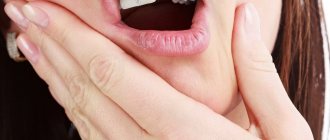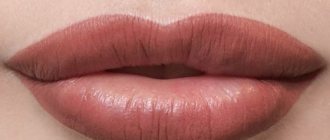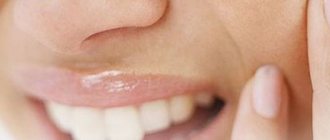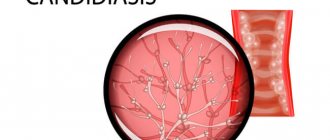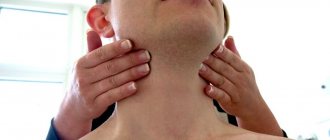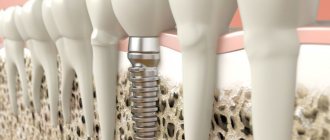These diseases are related to drug allergies, they spread to the oral cavity and can be combined with other lesions of the body. The most common cause is antibiotics (penicillin, tetracycline, streptomycin), sulfonamide drugs, analgesics, novocaine, iodine, bromides, etc.
The rate of development and severity of the allergic reaction depends on the method of administration of the drug. Often in pediatric dental practice, applications of painkillers and other medications are used. They most often cause sensitization. Frequent use and high dosage of the drug are also of great importance for the development of allergies.
The danger of drug allergies is that it combines all types of allergic reactions. This happens for several reasons. Firstly, as a result of the individual reactivity of the child’s body, as well as the presence of general somatic pathology. In addition, the nature of the drug allergen and the method of its administration are important.
Types of stomatitis
Depending on the nature of the disease and its clinical manifestations, experts divide catarrhal, catarrhal-hemorrhagic, as well as bullous, erosive, ulcerative-necrotic and allergic stomatitis.
The latter, in turn, is divided into the following types:
- medicinal;
- contact, for example, as an allergy to dentures, braces, plates;
- catarrhal;
- catarrhal-hemorrhagic;
- ulcerative-necrotic;
- erosive.
From the point of view of etiology and pathogenesis, allergic stomatitis includes medication, contact (including dentures), toxic-allergic, autoimmune dermatostomatitis, chronic recurrent aphthous stomatitis and other forms.
Depending on the speed of development of the reaction, doctors distinguish immediate and delayed types of allergic stomatitis. In the first case, angioedema is observed, and in the delayed type, the reaction to a particular irritant usually appears a few days after contact with the allergen.
In rare cases, allergic stomatitis develops while wearing dentures. Sometimes a reaction occurs even after 5–10 years of wearing them, after a long asymptomatic period.
Ask a Question
1.General information
If you see a person’s face rapidly swelling, especially in the area of the eyelids and lips, the first thing that should come to mind is Quincke’s edema.
Acutely developing angioedema (neurovascular) edema is named after the German physician Heinrich Quincke, who gave the first detailed clinical description in 1882 (casuistic references to similar conditions have been found before). It is interesting that the term “Quincke’s edema” is used mainly in German- and Russian-speaking medicine, while in international English terminology they usually talk about “angioedema”.
Angioedema is one of the specific types of hypersensitivity reaction and can occur in any of us, regardless of age and gender. However, the predominance of young women (20-30 years old) among those with diagnosed episodes of Quincke's edema is sometimes reported. On the other hand, there is a form of angioedema (or rather, three subtypes) with a hereditary predisposition, first described by W. Osler six years after the publication of G. Quincke; In the presence of a family history, men are more often affected.
According to statistics, in the United States alone, angioedema causes emergency room calls about one hundred thousand times each year, and it consistently leads in the total number of allergic reactions and conditions that lead to hospitalization.
Sign up for a consultation
A must read! Help with treatment and hospitalization!
Causes of the disease
As is clear from the name of the disease, a negative reaction of the body develops after contact with various allergens. Most often, allergic stomatitis occurs after contact with plant pollen or mold spores. The disease can also manifest itself against the background of:
- installation of crowns, fillings, prostheses made of low-quality materials;
- consumption of certain types of food (especially in children);
- decreased immunity;
- course of treatment with antibacterial drugs or sulfonamides;
- advanced caries;
- bleeding gums;
- inflammation of the oral cavity;
- proliferation of pathogenic microorganisms in the oral cavity.
Sometimes allergic stomatitis manifests itself as a complication of Lyme disease, systemic lupus erythematosus, aphthous stomatitis, hemorrhagic diathesis, and Stevens-Johnson syndrome.
Symptoms
The disease is characterized by general and local symptoms. The first symptoms of a mild form of allergic stomatitis are:
- slight discomfort in the oral cavity during hygiene procedures and eating;
- inflammation and swelling of tissues;
- redness and itching of the affected areas of the mucous membrane;
- excessive salivation.
If allergic stomatitis began while taking certain medications, the patient complains of painful blisters filled with liquid. Tick-borne borreliosis is accompanied by redness, blisters on the mucous membranes, as well as bleeding erosions and wounds.
Allergic stomatitis without proper treatment develops very quickly: the patient’s body temperature rises, and bubbles and blisters appear on the skin, mucous membranes of the eyes, and genitals.
If the disease was caused by Lyme disease, red spots with a border appear in different parts of the body and are very painful. Sometimes patients complain of joint pain.
Catarrhal and catarrhal-hemorrhagic stomatitis, cheilitis, glossitis
This is the mildest form of drug allergy. It is manifested by itching, burning, impaired taste sensitivity, dryness and pain when eating.
Clinical symptoms: hyperemia, swelling of the mucous membrane, as indicated by tooth marks on the lateral surfaces of the tongue and cheeks. Differential diagnosis is carried out with similar changes in the oral mucosa in cases of hypovitaminosis C, B, gastrointestinal diseases, infectious and fungal infections.
For this disease, both local treatment is used in the form of rinsing with antiseptic agents and taking painkillers, as well as general treatment: withdrawal of allergen medication, antihistamines (Diphenhydramine, Diprazin, Suprastin, Tavegil), calcium supplements. It is recommended to drink plenty of fluids and eat foods that do not irritate the mucous membranes.
Diagnostics
The diagnosis of “allergic stomatitis” is made by a dentist based on an examination of the oral cavity and questioning the patient about underlying diseases and medication use. The dentist clarifies the clinical picture of the disease.
The doctor must conduct a comprehensive examination and diagnosis:
- removable and fixed prostheses;
- braces;
- filling
To clarify the clinical picture of the disease, the specialist refers the patient for a comprehensive blood and urine test and an immunogram to assess the state of the immune system. If necessary, the doctor sends the patient for the following studies:
- determination of the acidity level and composition of saliva;
- identification of the activity of enzymes contained in saliva;
- leukopenic test;
- provocative tests with removal and subsequent installation of prostheses.
An integrated approach to diagnosing allergic stomatitis will allow you to quickly find out the cause of the negative reaction, eliminate it and begin effective treatment.
Treatment of allergic stomatitis in adults
If the dentist confirms the diagnosis, he first prescribes complex therapy. It is important not only to eliminate the painful external manifestations of the disease, but also to adjust drug treatment, change the patient’s lifestyle and, if necessary, discontinue medications that caused irritation.
Folk remedies are excellent aids in treating the disease, but using herbal infusions alone will not completely get rid of the disease. The main thing is to determine the cause of the allergy and eliminate it as soon as possible.
The main directions in the treatment of stomatitis are:
- identification and elimination of allergens;
- selection of suitable orthopedic structures (if an allergy to them is identified);
- replacement of low-quality fillings;
- selection of softer and more gentle medications;
- taking antihistamines and antiallergic drugs;
- use of local antiseptics and painkillers;
- disinfection of mucous membranes by rinsing in order to reduce the risk of infection spreading through the bloodstream throughout the body;
- taking analgesics and anti-inflammatory drugs.
Treatment of allergic stomatitis necessarily includes a hypoallergenic diet. In order for the aphthae to heal as soon as possible, and the patient no longer suffers from painful sensations in the oral cavity, the following should be excluded from the diet during treatment:
- sour, spicy and salty foods;
- citrus;
- fried foods;
- peppered dishes.
During treatment, it is recommended to eat soft foods, such as purees or soups. It is important not to injure the affected and swollen mucosa, so that the wounds heal as soon as possible and the swollen mucosa is not injured.
Additional treatment
As prescribed by the dentist and allergist, the patient can use various herbal decoctions and healing oils as additional treatment. The most effective recipes are:
- Aloe juice. The juice of the plant perfectly relieves inflammation, heals ulcers and wounds. You can rinse your mouth with the fresh juice, or you can chew the pulp of the fleshy leaf, peeled.
- Sea buckthorn oil . This oil can treat stomatitis of any form, including allergic ones. You can prepare the oil yourself or buy it at a pharmacy. To supplement the treatment, it is enough to lubricate the affected tissues several times a day. Sea buckthorn will heal wounds, soften the mucous membrane and reduce inflammation.
- Propolis . This beekeeping product perfectly relieves inflammation and heals ulcers and wounds, and also perfectly disinfects the mucous membrane. To treat stomatitis, it is enough to dilute a pharmaceutical tincture of propolis in water in a ratio of 1:10 and rinse your mouth with it.
- Chamomile infusion has excellent anti-inflammatory and wound healing properties. To treat the oral cavity, just pour 2 tablespoons of flowers into a thermos, pour 1 liter of boiling water into them and let it brew for 45 minutes. It is recommended to rinse your mouth with filtered infusion 3-4 times a day. Instead of chamomile, you can use an infusion of sage or calendula, and also prepare a mix, taking a teaspoon of each herb.
Erosive-ulcerative stomatitis, cheilitis, glossitis
This disease is manifested by hyperemia and swelling of the palate, gums, lips, tongue and cheeks, the appearance of blisters with transparent contents, after opening of which erosions are formed, covered with fibrinous plaque. These symptoms are accompanied by pain, which is aggravated by eating and talking. Weakness, loss of appetite, and increased body temperature up to 38C may appear.
The disease is easily confused with acute herpetic stomatitis, erythema multiforme and pemphigus, so the diagnosis is carried out by an allergist together with a dermatologist.
Treatment consists of discontinuing the intolerable drug and prescribing antihistamines. In severe cases, corticosteroids are prescribed. Local treatment includes painkillers and antiseptic treatment of the oral cavity. It is recommended to eat non-irritating foods and drink plenty of fluids.
Allergic stomatitis in children
In children, the disease occurs more often than in adults, and at the same time, a weak and fragile child’s body reacts more sharply to irritants. The baby begins to be capricious, complain of pain in the mouth and, of course, is afraid to go to the dentist.
In no case should parents let a child’s illness take its course, relying on traditional methods of treatment. If the baby suffers from allergic stomatitis, no ointments or rinses will cure him 100% as long as contact with the allergen continues. Sensitive thin mucous membranes easily crack, bleed, and pathogenic microorganisms quickly penetrate into the ulcers.
It is important to take the child to a specialist as soon as possible, explain to him that the doctor will help him get rid of the pain, and begin the examination.
Quincke's edema: outpatient care
Sudden local edema, called angioedema (angioedema, giant urticaria), is encountered in the practice of a doctor of any specialty. They were first described in 1882.
The origin of this swelling may be different. They often appear as a result of contact with an allergen, that is, as a result of an allergic reaction (a reaction that occurs through immunological mechanisms). But Quincke's edema can also be of non-allergic origin (pseudo-allergic reactions). In this case, the edema reflects some other somatic pathology, most often various diseases of the gastrointestinal tract and hepatobiliary system. But in addition to gastroenterological pathology, the tendency to local edema is influenced by dysfunction of the endocrine system (or disorders of neuro-endocrine regulation), chronic foci of infection, tumor (Quincke's edema as a paraneoplastic reaction), systemic and some other diseases, and parasitic invasion. There are also edemas that appear under the influence of chemical (including medications) and physical (temperature, pressure, vibration) factors. Quite often, angioedema develops under the influence of several factors. There is hereditary vibration angioedema. Its mechanism is not clear; An increase in histamine levels was found after exposure to a vibration stimulus. The type of inheritance is autosomal dominant.
The general pathogenetic mechanism of any angioedema is a violation of the permeability of the microvasculature with the subsequent development of local edema.
The localization of edema can be different: face, mucous membrane of the oral cavity and gastrointestinal tract, larynx, external genitalia, parenchymal organs and meninges.
In most cases, edema is accompanied by urticaria (and angioedema itself can be considered as a deeper manifestation of urticaria), but they can also be an independent disease.
Another disease has a similar clinical picture - hereditary angioedema (HAE), which occurs as a result of congenital pathology - deficiency or functional inferiority of the inhibitor of the first component of complement.
Treatment for angioedema is carried out in 2 stages: the first is relief of the acute condition, the second is treatment of the cause of the disease. Treatment includes elimination of identified causative factors, symptomatic therapy, basic therapy and prevention of exacerbations (prevention of relapses of edema).
Localization of edema in the face, neck, oral cavity, and larynx can lead to asphyxia. Therefore, in such cases, treatment measures should be carried out quickly and efficiently. Difficulty breathing caused by swelling of the airways is a direct indication for hospitalization of the patient. The development of laryngeal edema may require emergency intubation or tracheostomy.
In addition, indications for inpatient treatment include intestinal edema, hypovolemia, failure of outpatient treatment, or the development of any life-threatening complications of angioedema. If there is no threat to the patient’s life, then treatment can be carried out on an outpatient basis.
The most commonly used drugs in the treatment of angioedema are histamine H1 receptor antagonists: fexofenadine in a dose of 60 to 240 mg 1-2 times a day; desloratadine - 5 mg/day; loratadine - 10 mg/day; cetirizine - 10–20 mg/day; ebastine - 10 mg/day; acrivastine - 8 mg 3 times a day; clemastine - 1 mg 2 times a day orally, 2 mg 2 times a day parenterally; chloropyramine - 25–50 mg/day orally, 20–40 mg parenterally; diphenhydramine - 30–50 mg 1–3 times a day orally, 20–50 mg 1–2 times a day parenterally; hydroxyzine - 25–50 mg every 6 hours; chlorpheniramine - 4 mg every 4-6 hours.
In more severe cases of angioedema, as well as when treatment with antihistamines is ineffective, a short course of parenteral treatment with glucocorticosteroids is administered: prednisolone - 40-60 mg/day, dexamethasone - 8-20 mg/day.
Further treatment of recurrent angioedema (second stage of treatment) will depend on the form of the disease.
Angioedema, occurring through the mechanisms of true allergy, requires unconditional elimination (exclusion) or limitation of contact with identified allergens in case of household, epidermal, pollen, food, occupational, drug, insect, fungal allergies. Otherwise, the treatment will be ineffective.
In the event of the appearance of angioedema resulting from exposure to physical factors, it is necessary to limit their effect on the patient: use photoprotective creams for angioedema due to insolation, avoid wearing heavy objects, tight shoes, use belts for edema resulting from pressure, avoid eating ice cream and other chilled drinks and foods for cold swelling, etc.
If the swelling is of non-allergic origin, then treatment is carried out after an in-depth clinical examination. It includes therapy for identified somatic pathologies (including rehabilitation of chronic foci of infection, such as tonsillitis, treatment of parasitic infestations, correction of intestinal dysbiosis, treatment of thyroiditis, diseases of the gastrointestinal tract and hepatobiliary system and other diseases that contribute to the development of pseudo-allergy). Such patients are prescribed a nonspecific hypoallergenic diet, which involves limiting the consumption of foods rich in histamine, tyramine, and histamine liberators (Table 1, 2, 3).
Symptomatic drug treatment of chronic, recurrent angioedema is also carried out with antihistamines. With a weak response to H1 receptor antagonists, the following are added to therapy: histamine H2 receptor antagonists (ranitidine - 150 mg 2 times a day, cimetidine - 300 mg 4 times a day, famotidine - 20 mg 2 times a day); leukotriene receptor antagonists (montelukast - 10 mg/day); calcium channel blockers (nifedipine - 20–60 mg/day).
For angioedema associated with systemic connective tissue diseases, drugs used in rheumatology (hydroxychloroquine, dapsone, colchicine, sulfasalazine) may be effective.
Treatment of hereditary angioedema is fundamentally different from the treatment of angioedema. Unrecognized HAE and, accordingly, inadequate therapy in many cases result in death. Diagnostic differences between HAE and allergic edema are presented in Table 4.
In the acute period, HAE is relieved by the administration of fresh or fresh frozen native plasma (replacement of C1 inhibitor deficiency), intravenous administration of tranexamic or aminocaproic acid. Danazol 800 mg/day (or stanozolol 12 mg/day) can also be administered. For swelling in the face and neck, furosemide (Lasix) and dexamethasone are additionally administered intravenously.
All patients with angioedema must have an “allergy patient passport” or a medical bracelet with information about the disease.
For questions regarding literature, please contact the editor.
S. V. Tsarev , Candidate of Medical Sciences, State Research Center Institute of Immunology, FU Medbioextrem, Ministry of Health of Russia, Moscow
Table 1. Products that can provoke angioedema
| Foods containing histamine-releasing substances | Foods rich in biogenic amines |
| Chocolate, strawberries, citrus fruits, tomatoes, crustaceans and oysters, coriander, pork, fish, alcohol, nuts, peanuts | Chocolate, sauerkraut, ham, stale cheese, fermented cheese, red wine, beer, fish, sausage; there is a lot of histamine in overripe and fermented foods |
Nutritional supplements:
|
Table 2. Foods High in Histamine
| Products | Histamine content (µg/g) |
| Fermented cheeses | Before 1330 |
| Fermented wines | 20 |
| Fermented foods: | |
| sauerkraut | 160 |
| cured ham and beef sausages | 225 |
| pork liver | 25 |
| Canned foods: | |
| tuna | 10-350 |
| anchovy fillet | 20 |
| herring fillet | 33 |
| herring caviar | 350 |
| Spinach | 37,5 |
| Tomatoes | 22 |
Table 3. Foods High in Tyramine
| Products | Tyramine content (µg/g) |
| Cheeses: | |
| Roquefort | More than 3000 |
| Camembert | 20-86 |
| brie | 180 |
| griar | 516 |
| Cheddar | 1466 |
| fused | 50 |
| Brewer's yeast | 1500 |
| Pickled herring | 3030 |
| Avocado | 23 |
Table 4. Differential diagnosis of hereditary angioedema and allergic edema
| Clinical and laboratory signs | Hereditary angioedema | Allergic edema |
| Presence of atopic diseases | Very rarely | Often |
| Relationship to allergen exposure | No | Eat |
| Trauma Connection | Clear | No |
| Blood eosinophilia | No | Often |
| Local hyperemia and itching | No | Eat |
| Hives | No | Eat |
| Effect of antihistamines and corticosteroids | No | Eat |
| Cyclicality | Often | No |
| Total IgE level | Norm | Often elevated |
| Complement system defect | There is always | No |
Prevention of allergic stomatitis
Unfortunately, patients are not always able to prevent the development of allergic stomatitis. It is impossible to predict what the oral cavity's reaction to a foreign substance will be. If an immune reaction is suspected, the dentist may refer the patient to an allergist.
The main measures to prevent allergic stomatitis are timely visits to the dentist and treatment of caries, strengthening the immune system and using suitable products for daily oral hygiene. If detected early, the pathology can be successfully treated.
If you suspect that you or your child have allergic stomatitis, experience pain in the oral cavity, or find ulcers and aphthae on the mucous membrane, do not delay consulting a doctor. Experienced dentists at STOMA clinics will help you determine the source of allergic stomatitis, quickly get rid of the unpleasant manifestations of the disease and return to your normal life.
We will check all structures in the patient’s oral cavity, conduct allergy tests, and, if necessary, refer the patient to trusted allergists and other specialists.
Call and make an appointment by phone. STOMA clinics are open from Monday to Saturday. You can choose a conveniently located clinic; we are open in many districts of St. Petersburg.
What to do
If a patient has a swollen tongue, treatment primarily depends on what causes the swelling. First of all, the cause should be determined; only an experienced doctor can do this. If the cause is known and it is not life-threatening (for example, biting the tongue or being burned by too hot food), then you can try to relieve the unpleasant symptoms yourself. But if the cause of tongue swelling is an allergic reaction, self-medication is life-threatening.
There are many ways to relieve swelling using traditional methods. However, all of them are suitable only for cases where the cause of swelling is microtrauma of the tongue.
You can rinse your mouth with decoctions of medicinal herbs - chamomile, sage, calendula, eucalyptus. You can use baths and rinses made from chlorhexidine, various herbal balms and rinses. If the patient's tongue is swollen after tooth extraction, rinsing with herbal infusions will help. It should be remembered that in this case you should absolutely not rinse your mouth with hot infusion, it will only increase inflammation.
